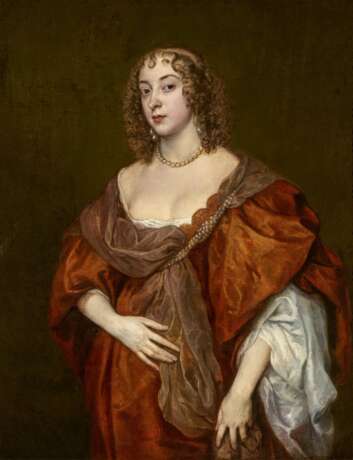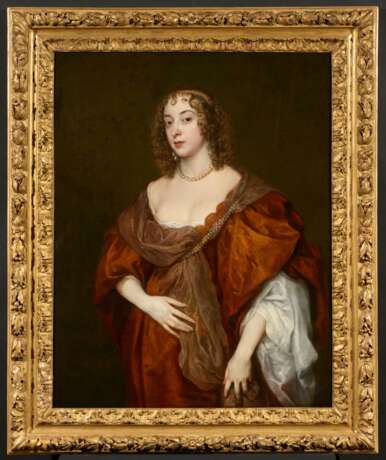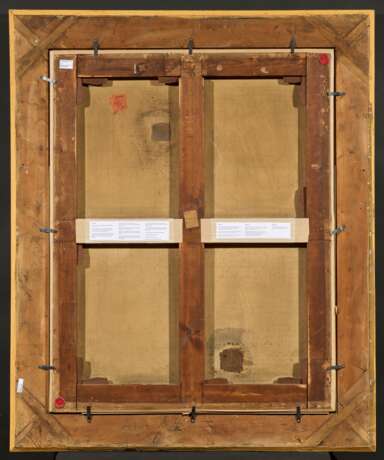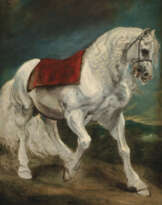ID 842467
Lot 636 | Anton van Dyck
Valeur estimée
€ 25 000 – 35 000
1599 Antwerp - 1641 London
Workshop / School
Title: Alleged Portrait of Elizabeth Howard.
Date: Ca.1638-1640.
Technique: Oil on canvas.
Mounting: Relined.
Measurement: 108 x 85cm.
Frame: Framed.
Verso:
On the stretcher seal Henkel Collection.
Provenance:
Presumably Edward Hyde, 1st Earl of Clarendon (1608-1674), and by inheritance to his son;
Presumably Henry, 2nd Earl of Clarendon (1638-1709), mentioned at Cornbury, Wiltshire, circa 1683-8 (as "14 Mrs. Howard"), and by inheritance to;
Presumably Henry Hyde, 4th Earl of Clarendon (1672-1753); in that part of the Clarendon collection which passed by inheritance to his daughter after the death of the 4th Earl in 1753;
Presumably Catherine, Duchess of Queensberry and Dover (died in 1777), and by inheritance to;
Presumably William Douglas, 4th Duke of Queensberry (1724-1810), and went by agreement (1810) to;
Archibald, 1st Lord Douglas (died in 1827), at Bothwell Castle, Lanarkshire, and by inheritance to his eldest daughter and co-heiress;
Jane Douglas (died in 1859), she married Henry Scott, 2nd Lord Montagu of Boughton (1778-1845), and by inheritance to her daughter;
Lucy Elizabeth Scott-Montagu, she married Cospatrick Alexander Douglas-Home, 11th Earl of Home (1799-1881), and by inheritance to;
Charles Cospatrick Archibald Douglas-Home, 13th Earl of Home (1873-1951);
Auction, Christie's, London, 20.06.1919, lot 105;
P. and D. Colnaghi and Company (London);
Frankfurter Kunsthandel;
Commerical Council Fritz Henkel;
Privat collection, France
Literature:
Lady T. Lewis, Lives of the friends and contemporaries of Lord Chancellor Clarendon: Illustrative of portraits in his Gallery, London 1852, volume III, p. 255;
L. Cust, Anthony van Dyck, an historical study of his life and works by Cust, London 1900, p. 276. no. 102 (as "Mary Howard, from the collection of the Earl of Home, Bothwell Castle");
Catalogue of Historical Portraits the property of the Rt. Hon. The Earl of Home ., 1919, (as "Portrait of Mrs. Mary Howard. Exhibited on the Grovesnor Gallery");
R. Gibson, Catalogue of portraits in the Collection of the Earl of Clarendon, London 1977, p. 143.
Exhibitions:
Exhibition of the works of Sir Anthony van Dyck - Grosvenor Gallery, London (England), 1887, no. 48, as "Mrs. Mary Howard (lent by the Earl of Home)";
Ausstellung alter Malerei aus Privatbesitz Kunstverein (Düsseldorf), Düsseldorf , 1929-06-01 - 1929-07-15 , no. 25, (lent by the Commercial Council Fritz Henkel).
The present work is listed and documented in the online database of the RKD, The Hague, under ill. no. 66056 (as Anton van Dyck).
The genre of the portrait had a similar purpose and meaning in the Ancien Régime, i.e. in a time without the internet, Instagram and means of reproduction, just as photography has today. It had to reflect the more or less idealised features of the person portrayed and at the same time convey their character, ambitions, and desires.
The portrait primarily functioned as a means of representation but also of propaganda, the transmission of an image and finally as a gift since there was generally a prototype of a copy that was then copied by the artist himself or by his workshop - if he had one - or by other artists who were not directly associated with him. In the case of artists who specialised in portraits or who devoted themselves to this genre at a certain stage of their career, one often sees several versions of the same portrait that either look identical or have variations.
The present work summarises what has just been said: it is the supposed portrait of a lady, probably of Elizabeth Howard, from the workshop of Anthony Van Dyck. Van Dyck experimented with all genres of painting during his short life: after moving to London in 1632, where he worked as a court painter, he became the favourite of the English aristocracy and the leading portrait painter for Charles I. Numerous portraits date from the English period, of the king and his family as well as of nobles and courtiers. His portraits were in great demand and even those already completed and delivered were replicated by the workshop. Copies of the prototypes were made and given to relatives or friends.
The portrait offered here, which shows an elegant and well-off lady in an orange robe and brown drapery, is a replica of a Van Dyck portrait from 1638-1640 that is part of a private collection in Antwerp. The master commissioned his workshop, which was instructed and trained in Van Dyck's style, to produce a second portrait identical to the first, probably intended as a gift or presentation for social purposes. The girl was hypothetically recognised as Elizabeth Howard, lady-in-waiting to Queen Henrietta Maria, second wife of Algernon Percy, 4th Earl of Northumberland, great-granddaughter of Thomas Howard, first Duke of Suffolk. This portrait shows the freshness and delicacy of Van Dyck's style and demonstrates that the workshop of such a famous and celebrated artist was also capable of producing works of the highest quality. This painting has often been confused with the original (in Antwerp private collection), which is why it is difficult to reconstruct the exact provenance of the work. We have therefore relied on the remains of the labels verso, which bear witness to the exhibitions in which it was shown, as well as the relevant exhibition catalogues.
| Artiste: | Antoine van Dyck (1599 - 1641) |
|---|---|
| Technique appliquée: | Huile |
| Catégorie maison de vente aux enchères: | Vieux maîtres |
| Artiste: | Antoine van Dyck (1599 - 1641) |
|---|---|
| Technique appliquée: | Huile |
| Catégorie maison de vente aux enchères: | Vieux maîtres |
| Adresse de l'enchère |
VAN HAM Kunstauktionen GmbH Hitzelerstr. 2 50968 Köln Allemagne | ||||||||||||||
|---|---|---|---|---|---|---|---|---|---|---|---|---|---|---|---|
| Aperçu |
| ||||||||||||||
| Téléphone | +49 221 92586215 | ||||||||||||||
| Fax | +49 221 92 58 62 4 | ||||||||||||||
| Commission | 32% | ||||||||||||||
| Conditions d'utilisation | Conditions d'utilisation | ||||||||||||||
| Heures d'ouverture | Heures d'ouverture
|














